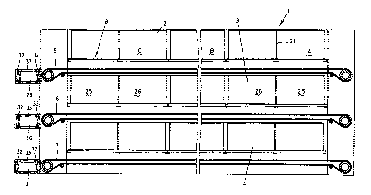Some of the information on this Web page has been provided by external sources. The Government of Canada is not responsible for the accuracy, reliability or currency of the information supplied by external sources. Users wishing to rely upon this information should consult directly with the source of the information. Content provided by external sources is not subject to official languages, privacy and accessibility requirements.
Any discrepancies in the text and image of the Claims and Abstract are due to differing posting times. Text of the Claims and Abstract are posted:
| (12) Patent: | (11) CA 2154283 |
|---|---|
| (54) English Title: | ARRANGEMENT FOR BREEDING POULTRY IN CAGE BATTERIES |
| (54) French Title: | DISPOSITIF POUR L'ELEVAGE DE VOLAILLES EN BATTERIES DE CAGES |
| Status: | Expired and beyond the Period of Reversal |
| (51) International Patent Classification (IPC): |
|
|---|---|
| (72) Inventors : |
|
| (73) Owners : |
|
| (71) Applicants : |
|
| (74) Agent: | SMART & BIGGAR LP |
| (74) Associate agent: | |
| (45) Issued: | 2001-06-05 |
| (86) PCT Filing Date: | 1994-01-29 |
| (87) Open to Public Inspection: | 1994-09-01 |
| Examination requested: | 1997-01-28 |
| Availability of licence: | N/A |
| Dedicated to the Public: | N/A |
| (25) Language of filing: | English |
| Patent Cooperation Treaty (PCT): | Yes |
|---|---|
| (86) PCT Filing Number: | PCT/DE1994/000096 |
| (87) International Publication Number: | DE1994000096 |
| (85) National Entry: | 1995-07-05 |
| (30) Application Priority Data: | ||||||
|---|---|---|---|---|---|---|
|
The invention relates to a cage battery for poultry
breeding in which the birds are removed by making the actual
grid base of the individual cages or cage sections removable,
ie. it may be rolled up, pulled out or folded up, while
beneath the grid base there is a conveyor belt capable of
removing the birds from the barn.
Note: Claims are shown in the official language in which they were submitted.
Note: Descriptions are shown in the official language in which they were submitted.

2024-08-01:As part of the Next Generation Patents (NGP) transition, the Canadian Patents Database (CPD) now contains a more detailed Event History, which replicates the Event Log of our new back-office solution.
Please note that "Inactive:" events refers to events no longer in use in our new back-office solution.
For a clearer understanding of the status of the application/patent presented on this page, the site Disclaimer , as well as the definitions for Patent , Event History , Maintenance Fee and Payment History should be consulted.
| Description | Date |
|---|---|
| Time Limit for Reversal Expired | 2012-01-30 |
| Letter Sent | 2011-01-31 |
| Inactive: Office letter | 2006-08-29 |
| Inactive: Corrective payment - s.78.6 Act | 2006-07-28 |
| Inactive: Entity size changed | 2002-10-25 |
| Grant by Issuance | 2001-06-05 |
| Inactive: Cover page published | 2001-06-04 |
| Pre-grant | 2001-03-05 |
| Small Entity Declaration Determined Compliant | 2001-03-05 |
| Inactive: Final fee received | 2001-03-05 |
| Letter Sent | 2000-11-30 |
| Notice of Allowance is Issued | 2000-11-30 |
| Notice of Allowance is Issued | 2000-11-30 |
| Amendment Received - Voluntary Amendment | 2000-10-30 |
| Inactive: Office letter | 2000-08-07 |
| Inactive: Approved for allowance (AFA) | 2000-07-28 |
| Amendment Received - Voluntary Amendment | 1998-12-04 |
| Inactive: Application prosecuted on TS as of Log entry date | 1998-05-12 |
| Inactive: Status info is complete as of Log entry date | 1998-05-12 |
| All Requirements for Examination Determined Compliant | 1997-01-28 |
| Request for Examination Requirements Determined Compliant | 1997-01-28 |
| Application Published (Open to Public Inspection) | 1994-09-01 |
There is no abandonment history.
The last payment was received on 2001-01-12
Note : If the full payment has not been received on or before the date indicated, a further fee may be required which may be one of the following
Patent fees are adjusted on the 1st of January every year. The amounts above are the current amounts if received by December 31 of the current year.
Please refer to the CIPO
Patent Fees
web page to see all current fee amounts.
| Fee Type | Anniversary Year | Due Date | Paid Date |
|---|---|---|---|
| Request for examination - small | 1997-01-28 | ||
| MF (application, 4th anniv.) - standard | 04 | 1998-01-29 | 1998-01-06 |
| MF (application, 5th anniv.) - standard | 05 | 1999-01-29 | 1998-12-17 |
| MF (application, 6th anniv.) - small | 06 | 2000-01-31 | 1999-12-13 |
| MF (application, 7th anniv.) - small | 07 | 2001-01-29 | 2001-01-12 |
| Final fee - small | 2001-03-05 | ||
| MF (patent, 8th anniv.) - standard | 2002-01-29 | 2001-10-31 | |
| MF (patent, 9th anniv.) - standard | 2003-01-29 | 2002-10-17 | |
| Reversal of deemed expiry | 2004-01-29 | 2003-11-13 | |
| MF (patent, 10th anniv.) - standard | 2004-01-29 | 2003-11-13 | |
| MF (patent, 11th anniv.) - standard | 2005-01-31 | 2005-01-07 | |
| MF (patent, 12th anniv.) - standard | 2006-01-30 | 2005-11-08 | |
| 2006-07-28 | |||
| MF (patent, 13th anniv.) - standard | 2007-01-29 | 2006-10-23 | |
| MF (patent, 14th anniv.) - standard | 2008-01-29 | 2008-01-16 | |
| MF (patent, 15th anniv.) - small | 2009-01-29 | 2009-01-15 | |
| MF (patent, 16th anniv.) - small | 2010-01-29 | 2010-01-19 |
Note: Records showing the ownership history in alphabetical order.
| Current Owners on Record |
|---|
| JOSEF KUHLMANN |
| Past Owners on Record |
|---|
| None |